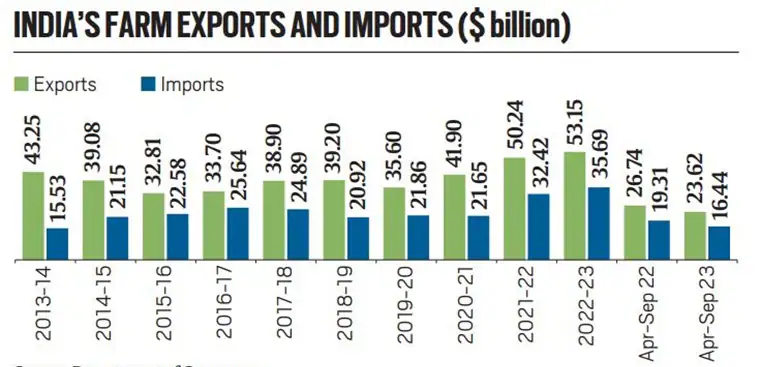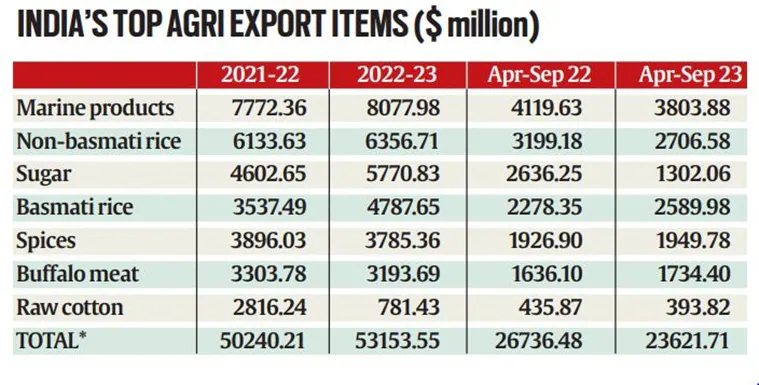Agriculture
India’s Falling Farm Exports
- 10 Nov 2023
- 6 min read
For Prelims: UN Food and Agriculture Organization’s (FAO), Food Price Index (FPI), Russia-Ukraine war, Inflation, Minimum Export Price (MEP), Non Basmati, Basmati,
For Mains: Concerns and Issues on economic growth and development due to falling farm exports in India.
Why in News?
According to recent Department of Commerce data, exports of farm commodities, at USD 23.6 billion in April-September 2023, were below the USD 26.7 billion for April-September 2022.
- There has been a drop in imports as well, from USD 19.3 billion to USD 16.2 billion resulting in a marginal dip in the agricultural trade surplus.
What are the Reasons Behind Falling Farm Exports?
- Government’s Restrictions on Exports:
- In the April-September 2023 period, India's agricultural exports declined by 11.6% compared to the previous year. This drop can be attributed to the government's implementation of bans and restrictions on the export of several commodities, including wheat, rice, and sugar.
- In September 2022, exports of broken rice were prohibited and a 20% duty levied on all white (non-parboiled) non-basmati grain shipments. In July 2023, exports of white non-basmati rice were banned altogether. Henceforth, only exports of parboiled non-basmati and basmati rice were allowed.
- The government of India , in May 2022, moved sugar exports from the “free” to “restricted” category and capped the total quantity of the sweetener that could go out during any year.
- In the April-September 2023 period, India's agricultural exports declined by 11.6% compared to the previous year. This drop can be attributed to the government's implementation of bans and restrictions on the export of several commodities, including wheat, rice, and sugar.
- Easing Global Prices:
- Additionally, global prices have softened after reaching their highest levels in the aftermath of Russia's invasion of Ukraine.
What is the Impact of Global Prices on Declining Food Export?
- India's Farm Trade and Its Connection to World Prices:
- India's agricultural trade, particularly its exports, exhibits a strong correlation with global price trends. This relationship is closely tied to the fluctuations in the UN Food and Agriculture Organization's Food Price Index (FFPI).
- FFPI Trends Impacting India's Agricultural Exports:
- The FFPI, reflecting international prices for a range of food commodities, has seen notable changes in recent years. India's agricultural exports tend to follow the FFPI's movements, declining from USD 43.3 billion in 2013-14 to USD 35.6 billion in 2019-20, along with the FFPI (from 119.1 to 96.5 points), and subsequently rising as the index reached unprecedented levels in 2022-23.
- Impact of Decreasing World Prices on India's Farm Trade:
- As global prices have receded, the value of both agricultural exports and imports in India is expected to decrease in 2023-24. This trend occurs despite the easing of supply disruptions resulting from the Russia-Ukraine conflict. The latest supply and demand brief from the Food and Agriculture Organisation (FAO) projects global ending cereal stocks for 2023-24.
What are the Consequences of Declining International Prices for Indian Agriculture?
- Reduces Farmers’ Incomes:
- Declining international prices not only lower the cost competitiveness of the country’s agricultural exports, but also make its farmers more vulnerable to imports. This is being witnessed in cotton and edible oils.
- The price crash has led to India’s cotton exports not only plummeting, but also imports surging 2.5 times between 2021-22 to 2022-23.
- Declining international prices not only lower the cost competitiveness of the country’s agricultural exports, but also make its farmers more vulnerable to imports. This is being witnessed in cotton and edible oils.
- Impact on Edible Oil:
- The value of India’s edible oil imports more than doubled between 2019-20 and 2022-23. This was primarily due to skyrocketing global prices, particularly post the war in Ukraine.
- What is more concerning is prices have since collapsed, but imports of crude palm, soybean and sunflower oil are still coming in at a low 5.5% duty.
- The value of India’s edible oil imports more than doubled between 2019-20 and 2022-23. This was primarily due to skyrocketing global prices, particularly post the war in Ukraine.
- Procedural Concerns:
- The government’s focus on controlling food inflation ahead of national elections – and prioritizing the interests of consumers over producers – means that imports of edible oil and pulses will continue unhindered, alongside restrictions on exports of cereals, sugar and even onion.
- This amounts to neglecting concerns of manufacturers and producers, which will impact GDP growth negatively.
- The government’s focus on controlling food inflation ahead of national elections – and prioritizing the interests of consumers over producers – means that imports of edible oil and pulses will continue unhindered, alongside restrictions on exports of cereals, sugar and even onion.
UPSC Civil Services Examination Previous Year Question (PYQ)
Prelims
Q. In India, which of the following can be considered as public investment in agriculture? (2020)
- Fixing Minimum Support Price for agricultural produce of all crops
- Computerization of Primary Agricultural Credit Societies
- Social Capital development
- Free electricity supply to farmers
- Waiver of agricultural loans by the banking system
- Setting up of cold storage facilities by the governments
Select the correct answer using the code given below:
(a) 1, 2 and 5 only
(b) 1, 3, and 4 and 5 only
(c) 2, 3 and 6 only
(d) 1, 2, 3, 4, 5 and 6
Ans:C
Q. What is/are the advantages/disadvantages of implementing the 'National Agriculture Market' scheme? (2017)
- It is a pan-India electronic trading portal for agricultural commodities.
- It provides the farmers access to nationwide market, with prices commensurate with the quality of their produce.
Select the correct answer using the code given below:
(a) 1 only
(b) 2 only
(c) Both 1 and 2
(d) Neither1 nor 2
Ans: C








